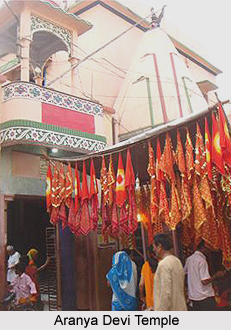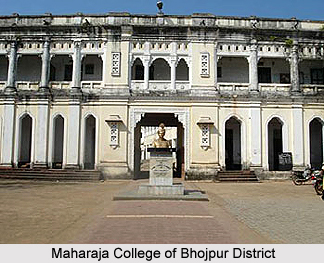 Bhojpur District is one of the administrative districts of Bihar and it has its headquarters at Arrah town. It is the principal town in Bhojpur District. Bhojpur District occupies a total of 2474 sq kms. It is situated at height of 192.989 meters from the sea level. Bhojpur District is located at longitude of 83 degree 45 minutes to 84 degree 45 minutes east and the latitude is 25 degree 10 minutes to 25 degree 40 minutes north. Bhojpur District is bounded by Chhapara and Ballia Districts of Uttar Pradesh in the north, by Rohtas District in the south, by Patna, Jahanabad District and Uarwal District in the east and by Buxar District in the west.
Bhojpur District is one of the administrative districts of Bihar and it has its headquarters at Arrah town. It is the principal town in Bhojpur District. Bhojpur District occupies a total of 2474 sq kms. It is situated at height of 192.989 meters from the sea level. Bhojpur District is located at longitude of 83 degree 45 minutes to 84 degree 45 minutes east and the latitude is 25 degree 10 minutes to 25 degree 40 minutes north. Bhojpur District is bounded by Chhapara and Ballia Districts of Uttar Pradesh in the north, by Rohtas District in the south, by Patna, Jahanabad District and Uarwal District in the east and by Buxar District in the west.
Bhojpur district has three sub-divisions namely Arrah Sadar, Jagdishpur and Piro and 14 development blocks. There are 1244 villages in the district. Administrative set-up of Bhojpur District includes 228 Panchayats and 12 revenue circles, 22 Police Stations, 5 Sub-Police Stations, 1 Railway Police Station, 7 Out-Post-Police Stations. Administration of Bhojpur District is headed by Deputy Commissioner with the aid of assistant officers.
History of Bhojpur District
Bhojpur District came into existence in the year 1992. Earlier this district was part of old Shahabad District. In 1972 Shahabad District was divided in two parts namely Bhojpur and Rohtas. Buxar was a subdivision of old Bhojpur District. In 1992, Buxar became a separate district.
 Geography of Bhojpur District
Geography of Bhojpur District
Geography of Bhojpur District consists of extremely fertile areas. In fact, this region is considered to be one of the best wheat-growing areas in Bihar. The district has rivers running through its three sides. Ganga River forms the northern boundary of the district. The low-lying rich alluvial plains in the north-eastern and owe their fertility to the river Ganges. The rivers Chher River and Banas River fall into the Ganges. Son River is another important river in the district. Son runs along the southern and eastern boundaries of Bhojpur District.
The climate of the district is of moderately extreme type. The hot weather season begins about the middle of March, when hot westerly winds begin to blow during the day. The months of April and May are extremely hot. Monsoon sets in by the third week of June and continues till about the end of September or the early part of October. The cold weather season begins from November and lasts till the beginning of March. Mines and minerals resources in new Bhojpur District are very little. The only mineral product in this district is the sand from Son River. In this district both the irrigated and un-irrigated areas except the small hills are being exploited for cultivation.
Demography of Bhojpur District
According to the Population Census in the year 2011, Bhojpur District had population of 2,720,155. Out of which the male and female were 1,431,722 and 1,288,433 respectively. The population of Bhojpur District constituted 2.62 percent of total population of Bhojpur District. The population census of 2011 shows the population density of Bhojpur district is 1,136 people per sq. km. Bhojpur district administers 2,395 square kilometers of areas. The average literacy rate of Bhojpur in 2011 was 72.79 percent compared to 58.96 of 2001. If things are looked out at gender wise, male and female literacy were 84.08 and 60.20 respectively. For 2001 census, same figures stood at 74.29 and 41.80 in Bhojpur District. The total literate in Bhojpur District were 1,659,049 of which male and female were 1,010,138 and 648,911 respectively.
Tourism in Bhojpur District
Tourism in Bhojpur District includes visits to several sites mainly religious sites and historical sites. Sun Temple at Dev village, Veer Kunwar Singh Kila, Jagdishpur, Maharaja College, Arrah, Shahi Masjid, Karbala, Mosque of Maulabagh, Aranya Devi Temple, Chaturvuj Narayan Mandir, Bhavani Mandir, Devi Jagdamba Mandir, Mahamaya Mandir and Venkatesh Mandir are some of the major attractions of Bhojpur District. All these places reflect the rich history of the region. These tourist attractions are worth visiting.
Bhojpur District has different types of small and cottage industries other than the agro-based industries.






